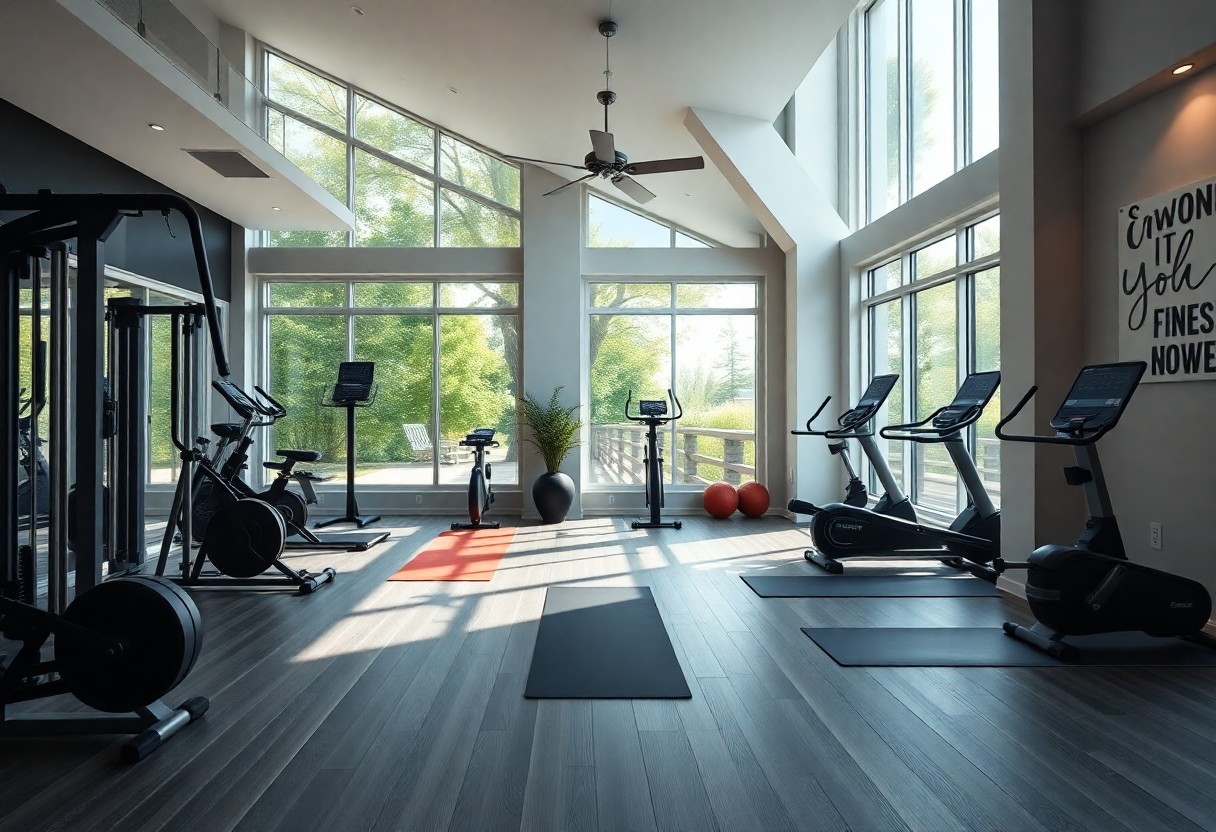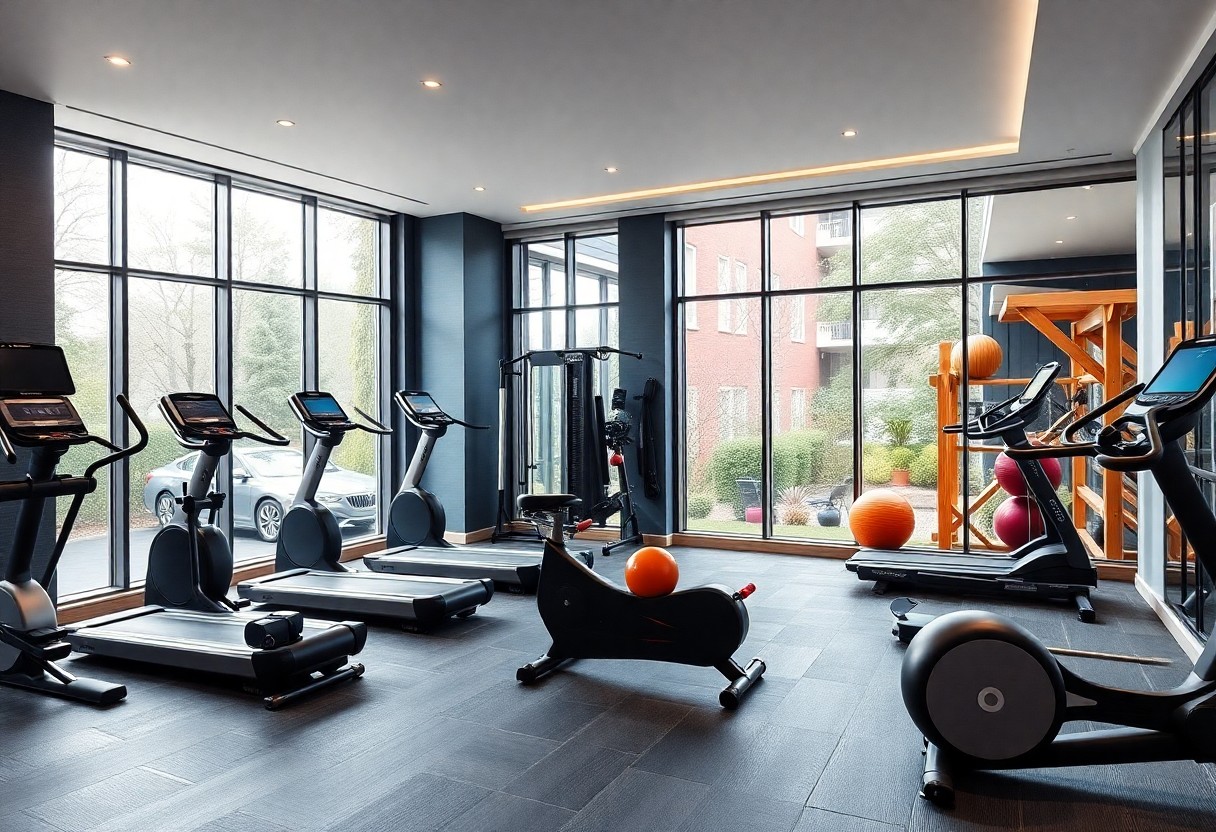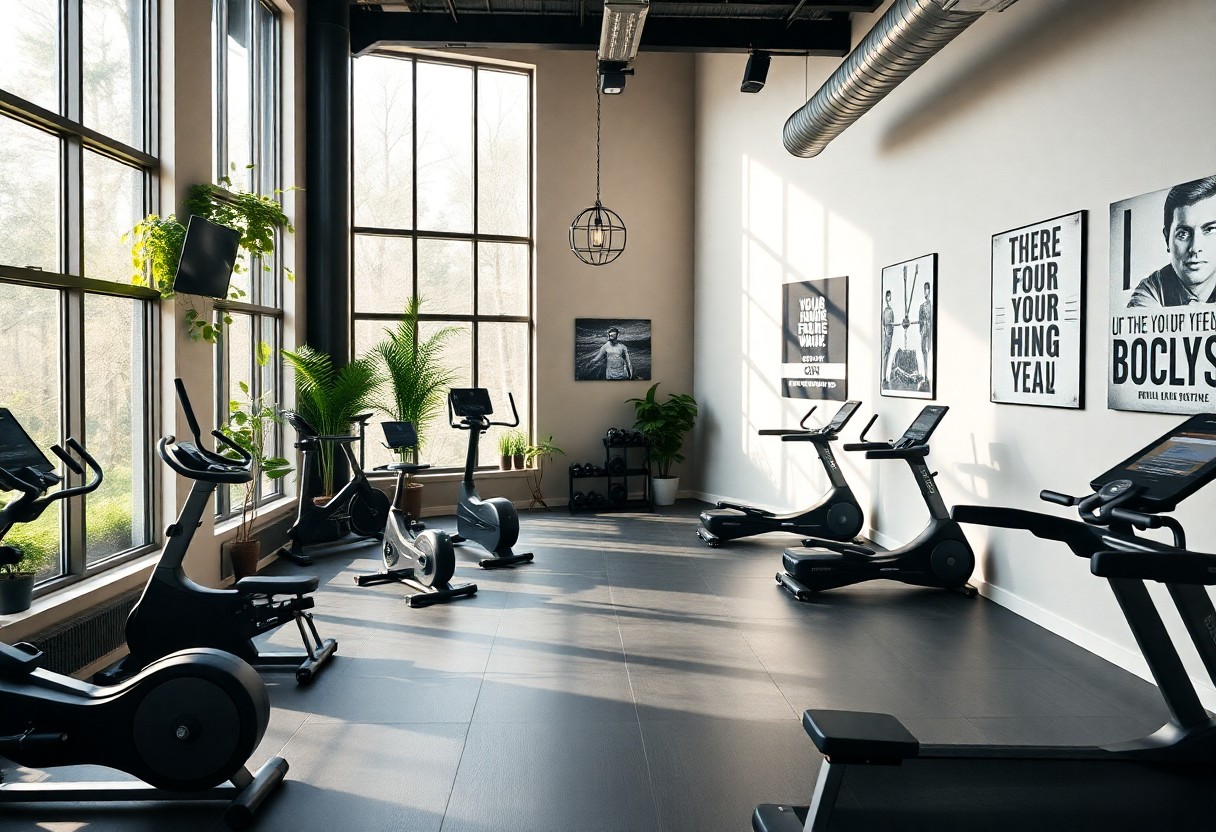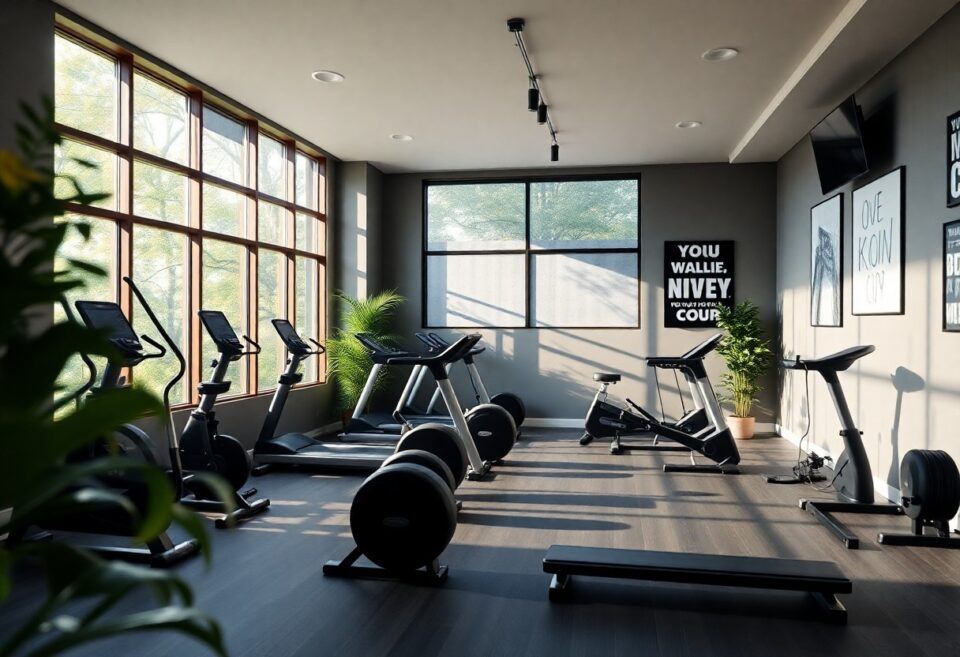Inexorably reshaping your fitness routine, home gyms have exploded in popularity in 2025, empowering you to take control of your health like never before. By creating a personalized workout space, you eliminate barriers such as gym crowds and time constraints, enhancing consistency and motivation. However, it’s important to carefully select safe and effective equipment to avoid injury. Embracing this trend means you invest in your well-being with unmatched convenience, blending technology and style to elevate your exercise experience right at home.

Shifting Paradigms: How the Pandemic Changed Fitness Routines
The global pandemic fundamentally altered the way you approach fitness, transforming what were once routine activities into innovative personal experiences. With gyms closing their doors and public spaces restricted, you found yourself seeking alternatives to maintain your health and well-being within the safety of your home. This enforced change sparked a renaissance in your fitness habits, emphasizing convenience and adaptability over traditional gym memberships. The sudden shift meant prioritizing workout effectiveness over location, prompting you to reimagine what a complete fitness routine could look like when confined to a personal space.
As social distancing measures persisted, you began to appreciate the value of exercising in a comfortable, familiar environment. The home gym emerged not just as a temporary solution but as a sustainable lifestyle choice. This paradigm shift dismantled previous barriers such as commuting time, crowded facilities, and rigid schedules. You discovered that a well-equipped home gym could provide a tailored workout experience that fits your unique goals and rhythms, empowering you to take full control of your fitness journey. This new approach fostered consistency and encouraged deeper engagement, as the gym was now intimately integrated into your daily life.
Moreover, the pandemic highlighted the importance of mental health alongside physical fitness. Your home gym became a sanctuary of personal well-being, a place to reduce stress and build resilience against external uncertainties. The intersection of health, convenience, and safety caused by the pandemic has permanently redefined your expectations and preferences in fitness routines. You now recognize that flexibility and self-sufficiency in your workouts provide enduring benefits that extend far beyond the immediate crisis, ensuring that your fitness regimen is both adaptive and future-proof.
The Influence of Digital Fitness Platforms on Home Workouts
Digital fitness platforms have revolutionized the way you engage with home workouts, making high-quality training virtually accessible at your fingertips. These platforms offer diverse programs tailored to every fitness level, eliminating the need for expensive personal trainers or gym memberships. Through interactive videos, live classes, and personalized coaching, you can access professional guidance anytime, anywhere. This democratization of fitness expertise empowers you to experiment with different workout styles, track progress meticulously, and stay motivated through virtual communities. The seamless integration of technology into your home gym setup provides you with unparalleled convenience and variety.
However, with great accessibility comes the responsibility to navigate these platforms wisely. While many digital options boast comprehensive content and user-friendly interfaces, you must remain cautious of programs that promise rapid results without adequate scientific backing. It’s vital to choose platforms that prioritize safe exercise practices and align with your individual health conditions. Some digital workouts might inadvertently encourage overexertion, increasing the risk of injury in the absence of professional supervision. Therefore, your critical evaluation of content credibility and adherence to personal limits is paramount to sustainable progress and safety in your fitness routine.
On the positive side, digital fitness platforms foster a sense of community and accountability that can be difficult to replicate in traditional home workout settings. By connecting with fellow users, sharing achievements, and participating in challenges, you experience enhanced motivation and commitment. Additionally, many platforms incorporate AI-driven analytics to refine your workout plans according to your evolving performance, making your fitness journey increasingly personalized and effective. The technological exoskeleton supporting your home gym thus opens doors to a dynamic, engaging, and scientifically-informed approach to health that once seemed out of reach.
Expanding on these benefits, digital fitness platforms also provide an invaluable resource for diversification in your workouts. They offer not only strength and cardio routines but also niche disciplines such as yoga, Pilates, dance, and mindfulness practices. This vast array allows you to cultivate both physical and mental wellness in an integrated manner. Importantly, the on-demand nature of digital content breaks down scheduling barriers, letting you fit workouts precisely around your lifestyle rather than the other way around. By leveraging these platforms, you elevate your home gym experience into a holistic fitness ecosystem that adapts to your personal needs and goals.
Innovative Equipment: Merging Fitness with Technology
When you step into your home gym in 2025, you’ll notice how innovative equipment has transformed traditional workouts into immersive experiences. The latest machines integrate cutting-edge technology, such as virtual reality and smart sensors, to provide real-time feedback on your form, intensity, and progress. This means you no longer need to guess whether you’re performing exercises correctly — your equipment guides you toward optimal technique, which not only enhances your results but also minimizes the risk of injury. Imagine a treadmill that adapts its speed and incline based on your heart rate or a weight machine that automatically adjusts resistance to match your strength for each set. This level of personalization makes your fitness routine more efficient and engaging.
You’ll also find that these advancements make workouts more accessible and enjoyable. Interactive screens and apps allow you to join live classes, compete with friends, or even explore scenic running paths from around the world without leaving your home. The equipment itself becomes an instructor, providing motivational prompts and adjustments to keep you challenged at just the right level. This fusion of fitness and technology turns your home gym into more than just a room with machines; it becomes a dynamic training environment designed specifically for you.
Moreover, the smart integration of your home gym equipment with wearable devices and fitness apps enables a comprehensive tracking system that records your performance, sleep quality, nutrition, and recovery time. By analyzing these data points, you can make informed decisions to tweak your workouts and lifestyle, achieving better results more quickly. This seamless blend of hardware and software pushes beyond traditional exercise routines, empowering you to take control of your health and fitness journey with precision and confidence.
The Role of AI and Personalized Training in Home Fitness
Artificial intelligence (AI) is revolutionizing the way you train at home by offering highly personalized workout plans tailored specifically to your goals, preferences, and biometric data. Unlike generic programs, AI-powered trainers analyze your performance, adjusting workouts in real time to ensure maximum effectiveness and prevent plateaus. This means your training evolves alongside your progress, pushing you just enough to improve without causing burnout or injury. The presence of AI acts as your personal coach who is available 24/7, guiding you through each session with expert precision.
You’ll also discover that AI enhances motivation and engagement by providing instant feedback and gamifying your fitness routines. With AI algorithms designed to learn your habits and preferences, workouts become more enjoyable through customized challenges and rewards. This approach not only keeps you consistent but also helps in building long-term habits that stick. In addition, some AI-driven platforms provide mental wellness support by incorporating mindfulness and recovery techniques as part of your overall fitness plan, highlighting the holistic nature of modern training systems.
While AI offers undeniable benefits, it’s important to recognize potential concerns such as data privacy and the risk of over-reliance on technology without human oversight. You must ensure your data is protected and still engage periodically with human fitness professionals for well-rounded guidance. When used responsibly, however, AI stands out as a powerful tool that transforms your home fitness experience from static routines to dynamic, data-driven coaching.
Expanding beyond mere workout adjustments, AI in home fitness helps you make smarter decisions by compiling and analyzing vast amounts of health data—from your recovery times to nutrition habits—allowing for comprehensive lifestyle recommendations specifically for your needs. This advanced insight can alert you to overtraining risks or inconsistencies early, potentially avoiding serious injuries or setbacks. In essence, the combination of AI and personalized training not only boosts your physical performance but also enhances safety and sustainability in your fitness practices.
Spatial Considerations: Making the Most of Limited Space
When setting up your home gym, one of the most common challenges you face is dealing with limited space. Whether you live in a cozy apartment or a compact house, maximizing every square inch is key to creating an effective workout environment. Start by assessing the available area and envisioning how you want to move through your exercises. You might find creative solutions like utilizing under-bed storage for lighter equipment or opting for foldable benches and racks that can be tucked away when not in use. Efficient organization and thoughtful layout can transform even a small room into a versatile gym.
Another powerful approach involves prioritizing vertical space. Installing wall-mounted racks for weights and resistance bands keeps your floor clear, reducing trip hazards and fostering a safer workout area. Mirrors can enlarge the perception of space while helping you check your form, which is crucial for avoiding injuries. Integrated storage, such as shelving units or pegboards, can house smaller gear and accessories neatly. When you consider how the space functions beyond just storing equipment, you enhance your home gym’s usability and ambiance.
Finally, lighting and ventilation play a significant role in your spatial experience. Natural light invigorates your workout mood and makes the space feel more open, so if possible, situate your gym near windows or glass doors. Good airflow prevents the buildup of stale air and sweat odors, impacting your comfort and motivation. Smart design choices like these ensure that your limited square footage doesn’t limit your fitness goals. By combining adaptive storage solutions with strategic use of light and air, you create a home gym that’s not only practical but rewarding to use.
Must-Have Equipment for Every Fitness Level
Equipping your home gym properly is crucial, regardless of your current fitness level or workout preferences. For beginners, a selection of adjustable dumbbells and resistance bands offer tremendous versatility without overwhelming your space. These items allow you to perform a wide range of exercises, from strength training to mobility work. As you progress, you can add more sophisticated equipment like a weight bench or a pull-up bar to challenge yourself further. Ensuring your choices match your capacity helps prevent injuries and encourages consistent workouts.
More advanced fitness enthusiasts will want to consider incorporating cardio machines like a treadmill, rowing machine, or stationary bike. Pairing these with free weights, kettlebells, and a stability ball gives you the ability to craft holistic routines that improve endurance, strength, and flexibility. However, it’s crucial not to overload your space or budget with unnecessary gear. Focus on quality over quantity to maintain both your safety and enthusiasm. A clutter-free environment allows you to focus fully on your performance.
Functional equipment such as medicine balls, jump ropes, and yoga mats are valuable additions that cater to all fitness levels. These tools enhance dynamic movement, coordination, and balance, which are often overlooked yet fundamental components of overall health. By including multipurpose items that you can adapt as your abilities grow, you create a home gym that evolves with your needs. A well-rounded mix of equipment not only supports varied workouts but also boosts your confidence and enjoyment.
In essence, selecting the right equipment for your home gym involves balancing your current abilities with your fitness ambitions. Consider how each piece of equipment serves your goals both now and in the near future, and choose items that are space-efficient and safe. By curating a collection that grows with you, your home gym becomes a personalized sanctuary that fuels progress and resilience year after year.

Building a Routine: Strategies for Consistency and Accountability
Establishing a consistent workout routine when you have a home gym requires deliberate effort and strategic planning. You need to set specific goals that align with your lifestyle and fitness level to maintain motivation over time. For instance, scheduling your workouts at the same time each day can help create a sense of habit, preventing your fitness routine from being overshadowed by daily distractions. Building in variety such as alternating between strength training, cardio, and flexibility exercises also keeps sessions engaging, which reduces the chance of burnout or boredom. By designing your routine with intention, you ensure that your home gym becomes an active, integral part of your daily life rather than a fleeting enthusiasm.
Accountability is another powerful factor in sustaining consistency. Although you work out in the privacy of your home, you can cultivate accountability by sharing your progress with a friend or joining online fitness communities where you can exchange experiences, tips, and encouragement. Setting measurable benchmarks, like increasing reps or weight gradually, enables you to track improvements and stay motivated. Additionally, integrating technology such as fitness apps or smart devices can remind you to stick with your programs and provide real-time feedback, making the process more interactive and rewarding. These strategies turn your routine into a dynamic system where you hold yourself responsible in manageable, positive ways.
Lastly, it is important to anticipate obstacles that may interrupt your routine and proactively create solutions. Life events, work demands, or even temporary illness can threaten your consistency, but having contingency plans—such as shorter workout options or recovery exercises—helps you stay on track without feeling discouraged. Making space in your environment for your fitness equipment accessible and organized reduces barriers to getting started, ensuring that your motivation translates effectively into action. By reinforcing these structured habits and committing to flexibility, you strengthen the foundation that sustains your home gym journey, promoting long-term success.
Mindset Shifts: Transforming Your Home into a Fitness Sanctuary
Transforming your home gym from just another room into a fitness sanctuary begins with a profound mindset shift. You need to view this space not simply as a makeshift gym but as a personal retreat dedicated to your well-being and growth. This requires you to foster a sense of respect and intentionality every time you enter the space, signaling to yourself that your workouts deserve focus and effort. Treating your home gym as a sanctuary elevates the mental significance of your sessions, making it easier to prioritize fitness even amidst a busy schedule. When you embrace this mindset, you reinforce the positive association between your environment and your commitment to health.
Another crucial mindset change involves shifting your perspective from seeing exercise as a chore to recognizing it as an opportunity for self-care and empowerment. You can approach each session as a chance to reconnect with your body, relieve stress, and cultivate strength. This transformation in thinking helps counteract feelings of obligation or guilt that sometimes accompany fitness regimes. Instead, you nurture a genuine sense of enjoyment and accomplishment, which feeds back into sustaining motivation. By consciously reframing your attitude, you create an inviting atmosphere that supports both physical and mental well-being within your home gym.
Finally, integrating mindfulness into your home workouts can deepen the sanctuary effect. Paying close attention to your breathing, movement quality, and sensations during exercise enhances body awareness and presence. This internal focus not only improves physical outcomes but also turns fitness into a meditative practice that benefits your entire lifestyle. Adopting this holistic approach transcends typical treadmill monotony and builds a profound, dynamic connection between mind and body. Recognizing your home gym as a sanctuary means that each workout becomes a practice in balance, resilience, and self-love rather than mere physical exertion.
Embracing the mindset shifts necessary to transform your home gym into a fitness sanctuary involves more than just physical changes—it demands a realignment of your emotional and psychological relationship with exercise. You will likely find that the positive reinforcement gained from treating your workout space with reverence leads to a deeper commitment and enjoyment. However, neglecting these critical mindset adjustments can make the space feel uninspiring or even burdensome, undermining your consistency. Cultivating this mindset ensures that your home gym truly supports your holistic health goals, turning it into a powerful source of motivation and personal transformation.

Financial Benefits: Cost-Effectiveness Compared to Commercial Gyms
When you consider setting up a home gym, the initial investment might seem substantial, but over time, you’ll find that it’s a financially prudent choice. Unlike commercial gyms where monthly membership fees accumulate, a home gym requires a one-time purchase of equipment. This eliminates recurring costs and allows you to exercise without the pressure of ongoing expenses. Additionally, by avoiding commute expenses such as fuel, public transportation, or parking fees, you save even more money.
Moreover, you won’t be tempted by additional spending that often happens in commercial gyms, such as purchasing protein shakes, supplements, or branded workout clothing. By working out in your own space, you create a more controlled environment where incidental expenditures are minimized. Over the course of a year, these savings can significantly surpass the upfront cost of your home gym setup. The convenience factor, paired with fiscal advantages, helps you make a strong case for investing at home rather than committing to lengthy gym contracts.
To provide you with a clearer comparison, here’s a breakdown of expenses you might face with a commercial gym versus a home gym:
| Commercial Gym Costs | Home Gym Costs |
|---|---|
| Monthly Membership Fees ($30 – $100) | Initial Equipment Purchase (varies $200 – $2000) |
| Travel Expenses | No Travel Expenses |
| Additional Purchases (Supplements, Gear) | Minimal or Controlled |
| Time Cost (Waiting for Equipment, Peak Hours) | Flexible Access Anytime |
Future Trends: Forecasting Growth in the Home Fitness Industry
The home fitness industry is poised for remarkable growth in 2025, powered by a blend of technological advancements and shifting consumer preferences toward health and convenience. As you invest in your personal fitness journey, you’ll notice an increasing integration of smart equipment, virtual instructors, and AI-driven workout programs that adapt in real-time to your performance. These innovations allow you to tailor workouts specifically to your goals, ensuring more effective results and heightened engagement. Additionally, the convenience of exercising in your own space means that the barriers of time and environment, which often impede traditional gym attendance, are significantly lowered.
Consumer trends are also favoring multi-functional and space-saving equipment, which further encourages people like you to convert spare rooms or small areas into efficient workout zones. The rise of community-based fitness platforms and social sharing apps enhances motivation and accountability, mimicking the social aspects of gyms without the need to leave home. The demand for personalized, on-demand fitness experiences aligns perfectly with the busy lifestyles that many people lead today.
It’s important to note that while the home gym sector is expanding rapidly, potential challenges such as equipment upfront costs and limited space in some homes may affect adoption rates. However, as technology becomes more affordable and compact, these barriers will continue to diminish, boosting market penetration. Overall, by embracing the future trends in home fitness, you are likely to experience not only enhanced physical health but also greater financial and lifestyle flexibility.
Looking ahead, the surge in wearable fitness tracking devices and data-driven fitness optimization services will further empower you to monitor progress with precision and customize routines effectively. This fusion of technology and convenience is set to transform the fitness experience fundamentally, making home gyms not just a stopgap option but a preferred lifestyle choice for an increasing number of fitness enthusiasts worldwide.
Final Words
Conclusively, as you navigate the fitness landscape in 2025, embracing the home gym trend can significantly enhance the way you approach your health and wellness. The convenience of having a dedicated workout space in your own home empowers you to design your exercise routine on your terms, fitting seamlessly into your schedule without the constraints of gym hours or commute times. By investing in your home gym, you’re not just creating a physical space; you’re fostering a sustainable habit that supports consistency and motivation in your fitness journey.
Your home gym also offers unparalleled customization, allowing you to choose equipment and workout styles that align perfectly with your preferences and goals. Unlike traditional gyms, where you might have to wait for machines or compromise on space, your home setup provides the freedom to experiment and tailor every aspect of your workout environment. This level of personalization encourages you to explore new training methods, integrate technology effortlessly, and adjust your routine as your fitness evolves over time.
Finally, the growing trend of home gyms reflects a broader shift towards health empowerment and self-care, highlighting how you can take ownership of your wellbeing in a way that suits your lifestyle. By making your home gym a central part of your daily routine, you’re investing in long-term benefits that extend beyond physical fitness, enhancing mental clarity and overall quality of life. In this unstoppable trend of 2025, your commitment to creating and maintaining a home gym positions you at the forefront of a movement that values flexibility, personalization, and holistic wellness.
